Listen closely because your spark plugs may be trying to tell you something.
Is your engine running too lean? Too rich? Is there an issue with oil control or ignition timing? Or is everything just fine with your engine? Like the mechanical version of the Magic 8-Ball, your spark plugs may have the answers for you. The trick is learning how to read your spark plugs.
With help from the spark plug experts at NGK, we’ll teach you how to diagnose minor tuning issues or potentially major engine problems by examining your spark plugs. Check out the images below, courtesy of NGK Spark Plugs, and get ready to do a little light reading the next time you pull your spark plugs.
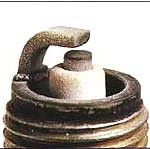 Normal
Normal
Appearance: A light tan/gray or brownish color, along with very little electrode erosion, indicates optimal operation conditions, including a healthy engine and correct spark plug heat range.
 Deposits
Deposits
Appearance & Symptoms: The electrodes—center and ground—are covered in an ashy coating. As a result of this masking of the electrodes, your engine may experience a misfire. This build-up of combustion deposits can eventually (but not usually) fill in the space between the two electrodes.
Possible Causes: Oil leaks, poor fuel quality.
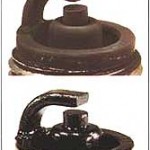 Wet and Dry Fouling
Wet and Dry Fouling
Appearance & Symptoms: Dry fouling (top) appears as sooty, black build-up. Wet fouling (bottom) has a wet, sometimes oily appearance. Both conditions can create poor starting and misfiring.
Possible Causes: Depending on whether the spark plug is coated in oil or fuel, wet fouling can be symptomatic of a compromised head gasket, poor control from your pistons’ oil control ring, valvetrain problems, or an extremely rich condition. Dry fouling, or carbon fouling, is often caused by an overly rich condition, and the problem may lie with your air cleaner (clogged) or carburetor. Other possible causes could be low compression, vacuum leak, overly retarded timing, or improper spark plug heat range.
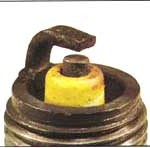 Lead Fouling
Lead Fouling
Appearance & Symptoms: Lead fouling can only occur in applications that use leaded gasoline, such as racing engines. Lead fouling generally shows up as yellowish brown deposits on the spark plug’s insulator nose. Lead fouling can cause your engine to misfire only at high-rpm and under hard acceleration.
Possible Causes: This condition commonly occurs when gasoline contains too much lead; however, because spark plugs are changed frequently in racing applications, lead fouling has become less common.
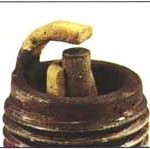 Breakage
Breakage
Appearance & Symptoms: The insulator around the center electrode may be broken (see left) or the ground electrode may be bent. Again, you will likely experience misfire and some power loss under these conditions.
Possible Causes: If the insulator is broken, it may be the result of sudden thermal expansion or thermal shock caused by extreme temperatures or temperature change. Detonation is often the culprit and can be caused by an extremely lean air/fuel mixture, drastically advanced timing, improper gasoline octane rating. A broken insulator can also be thermally triggered if cold fuel is sprayed on a hot insulator. Center and ground electrode damage is often the result of mechanical collision with internal engine components or excessive vibration. The mechanical collision occurs when a spark plug has too long of a reach. Vibration is generally the result of improper installation.
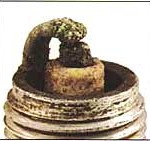 Melting
Melting
Appearance & Symptoms: In this case, the center or ground electrode is melted or scorched, and your engine may be experiencing some power loss.
Possible Causes: According to NGK, melting often results from loose installation, which prevents the plug from properly transferring heat from its tip. But melting may also indicate unusual heat or hot spots within the combustion chamber. This excessive heat is often the result of pre-ignition, which can be created by an overly lean condition, improperly advanced injection timing, or improper heat range (too low).
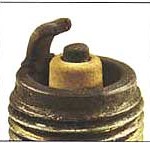 Lead Erosion
Lead Erosion
Appearance & Symptoms: The tip of the ground electrode looks chipped and its surface may be thinned.
Possible Causes: Another condition unique to leaded gasoline, this condition is caused by lead compounds that react chemically with the electrodes at high temperatures. This makes the electrode material (nickel alloy) weak and brittle. This is caused by too much lead in your gasoline.
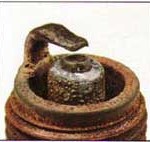 Erosion, Corrosion & Oxidation
Erosion, Corrosion & Oxidation
Appearance & Symptoms: A plug with a combination of erosion, corrosion, and oxidation will have pitted and rough electrodes and may even have a green cast if the oxidation is heavy. These conditions can result in increased, improper spark plug gap and yield poorer performance.
Possible Causes: Typically, these conditions occur over time as lead in the gasoline reacts with the electrode materials.
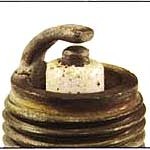 Overheating
Overheating
Appearance & Symptoms: The insulator will have a glazed white appearance and may have small black deposits. There may also be abnormal electrode wear, and you will likely notice a loss of power at high speeds or under high engine load.
Possible Causes: Overheating may occur from over-advanced ignition timing, poor cooling system efficiency, lean air/fuel mixture, vacuum leak, or wrong spark plug heat range (too low).

chequeen esto
[…] porcelain indicator suggest rich jetting. Tiny specks of metal indicate lean jetting. This post on how to read your spark plugs is geared toward automotive, but mostly applies here […]
[…] need to do after removing your spark plugs is to inspect and read them. You can view our post on How to Read Your Spark Plugs […]
[…] have a slightly rich condition to help prevent the engine from overheating. After initial start-up, check the spark plugs for proper reading (color) and adjust the carburetor(s) accordingly. You want to see a medium to dark tan […]
I really appreciate these reading. Contact here for more spark plug categories.
http://autoplicity.com/manufacturer/95-bosch-spark-plugs.aspx?categoryid=53
[…] Be sure to check out our earlier post on How to Read Your Spark Plugs. […]
[…] Re: '95 CPI Leaking fuel on the ground near exhaust manifold. First guess, you need to check the fittings connecting the fuel lines to the nut kit on the back of the lower intake manifold. That sounds like the location where B95's leak is coming from. Also, pop off the black cap on the test port on the supply line; is it wet? The Schrader valve in the test port could have failed, filling the cap and deflecting down towards the exhaust. It's a Schrader valve just like a bike tire. If it failed, bleed whatever pressure is on the line with a rag or by running the truck and pulling the fuse/relay for the fuel pump. Then change the valve just like a bike tire. As for Rhot's question, fuel leaking from the nut kit or the cpi will puddle in the lower intake manifold; most commonly in the area right under the entrance of the nut kit at the back if the intake. I'm unsure of the total volume it can hold but the lower manifold is 1.75-2" deep in most spots before the marriage gasket for the upper intake manifold. It would have to have been leaking heavily or for a long time to fill that much area. Some of it will naturally evaporate but I don't know where it could go other than eating the gasket material to get out. The nut kit is only sealed in with o-rings; if the LIM has a great deal of fuel in it, that's probably the easiest spot to push it out. The air runners are sealed from the throttle body down. The poppets all have rubber seals but those could probably degrade enough to allow fuel to seep into the cylinder. If they are degraded and there is a lot of fuel puddled, I'd be worried about a stray spark getting through. Pull the plugs and check the condition of the electrode. Running too rich? Other symptoms: http://www.onallcylinders.com/2012/1…r-spark-plugs/ […]
[…] Read More […]
[…] http://www.onallcylinders.com/2012/1…r-spark-plugs/ I did notice oil residue on the threads but nowhere on the electrodes. My humble, honest […]
[…] it. Link: Tech Talk #89 – The Eyes Inside Your Engine | Reher Morrison Racing Engines Link: Reading 101: How to Read Your Spark Plugs – OnAllCylinders […]
[…] Reading your spark plugs is a good way to tune your engine, adjust the air/fuel mixture, and check for detonation. And if the plugs have wet black deposits on the threaded portion and plug insulator, they may be telling you it’s time to replace worn out piston rings or intake valve guides. In this instance, the wet deposits are caused by oil entering the combustion chamber. […]
ok, 1970 351c 2v block fitted with 4v quench heads, bored .030 and decked .010, fresh rebuild car cranked, but sounded like crap. I pulled all the plugs, #5 (front right looking at car) looks like it hit top of piston, collapsed on top of electrode. All other plugs high carbon deposits, but no damage, how can one plug it and not the others, or is there something I am missing here.
mic tdc on all pistons at tdc and make sure #5’s tdc measurement is the same. had a jd motor out of a 89 front loader that had to have the pistons milled thousands off cause they slapped the head on tdc.
also check crank journals for excessive wear
[…] you changed the spark plugs, did you see the old ones? Were any of them fouled with wet deposits? Reading 101: How to Read Your Spark Plugs – OnAllCylinders At 114k miles, you should have already had the timing belt/water pump service performed. Has that […]
[…] would help, what your spark plugs look like can point you in the direction of your problem…. Reading 101: How to Read Your Spark Plugs – OnAllCylinders. 94 googletag.cmd.push(function() { googletag.display('div-gpt-ad-14'); […]
[…] do your plugs look like? Reading 101: How to Read Your Spark Plugs – OnAllCylinders 1969 Shelby GT350 Hertz rebuild Gallery Delivered to Ball Ford in Miami Florida, purchased […]
[…] from ngkReading 101: How to Read Your Spark Plugs – OnAllCylinders chart has color photos and causes. there is a gas station in town that sells racing fuel 100 + […]
[…] though. As for what's causing them to look the way they do, this article (with pics) should help. Reading 101: How to Read Your Spark Plugs – OnAllCylinders Reply With […]
[…] go beyond this range. Take a look at the spark plugs as you do this (here’s a guide to reading spark plugs). The plugs will tell you if the engine is running rich or lean, although you can also use an […]
1 out of the 6 spark plugs soaked with oil. Oil in exhaust. All other plugs dry soot. No smoke coming out of exhaust. 2-3 hrs running lost 3 quarts of oil.
Do you have a PCV system? If so bad valve or poor baffle under valve.
I have a Nissan b13 model with a GAv15 engine. plug number 2 has been dry fouling and I have replaced the valve seals and the piston rings but the same problem. what could be wrong?
Have you tried a different brand of spark plug? ie NGK Iridium (NGK 5464 BKR5EIX-11 Iridium IX Spark Plug) or the Bosch double iridium?
IF you foul a plug & clean it up,will it work or once a plug is fouled is still good after cleaning it?
If it’s visibly damaged on the exterior, then it’s pretty certain to be bad and need replacement. If it’s just dirty & has some dry soot or dry deposits that can be cleaned up with a brush that won’t damage anything & using some contact cleaner, brake clean, carb/tb clean, alcohol, etc. and you’ve fixed the problem that caused it to get that way in the first place, then it “should” be alright to re-use. However, unless it’s a really expensive, high-performance plug, I’d just replace it or all of them. Most plugs aren’t that expensive so it’s probably best to just fix the fault and replace all the plugs at the same time, unless again, it’s a really expensive or rare/hard to find plug type.
Dude if a plug is fouled. Throw it in the trash and buy new ones! Dang man if ya too damn cheap to buy a spark plug you prolly shouldnt be pullin a wrench on anything. Period! Just my opinion….. plugs are cheap……engines are not! Thats a fact
Dude. Not my horse, and dont know you but turned a wrench many a time where I barely had bucks to see if it would turn over. Beyond that. Good info to know in case something happens out in bfe . Agreed change the plugs but, if u can get to the house where there Are tools, much easier/safer to do that with no tow bill, jack stands. etc..
[…] Reading 101: How to Read Your Spark Plugs – OnAllCylinders […]
[…] ago, I was trying to tune the secondary jetting on a Q-jet on a small-block and it appeared by reading the plugs that the engine was too lean. So I richened the jetting several times and the car slowed down each […]
[…] entire engine depends on these little workers. So, it is crucial to find out how to examine them properly. Knowing how to clean spark plugs is a cheap way to maintain your car and keep it […]
[…] time, a deposit collects on spark plugs due to the combustion process, interfering with fuel ignition and performance. Furthermore, spark […]
[…] In a previous post, we showed you how to read your spark plugs. […]
[…] Carbon fouling indicates a weak ignition, rich air-fuel mixture, or improper heat range like too cold. Carbon deposit is conductive, and it may generate a way for the misfire of the spark plug. An overly rich state generally causes carbon fouling, or the problem can lie with the air cleaner or carburettor. […]
[…] Reading your spark plugs is a good way to tune your engine, adjust the air/fuel mixture, and check for detonation. And if the plugs have wet black deposits on the threaded portion and plug insulator, they may be telling you it’s time to replace worn out piston rings or intake valve guides. In this instance, the wet deposits are caused by oil entering the combustion chamber. […]
[…] Now, I’m not sure if that’s because the finish on the SilencerCo muzzle brake is better. This might be caused by the additional gas ports on the Dragon muzzle brake. That means more gas gets vented out the body of the brake, rather than the muzzle, which may cause more carbon fouling. […]
[…] found a few more examples with pictures that look very similar to mine which say it’s ash […]